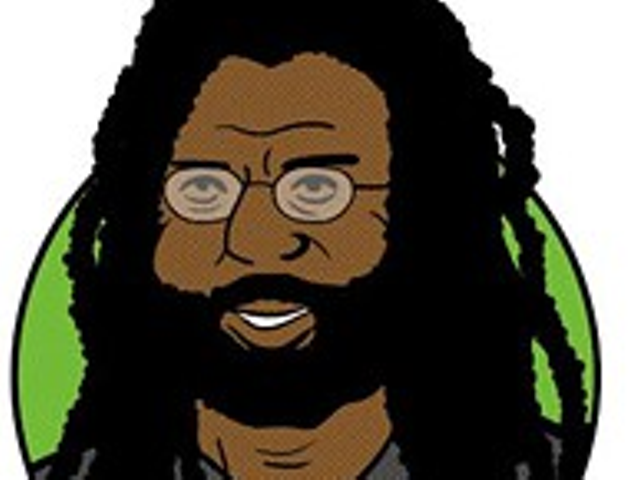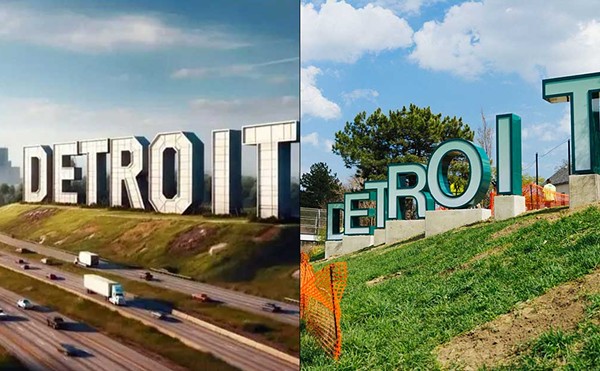Tucked behind the Fillmore is a building that's all but invisible, despite prime location in Detroit's pedestrian-heavy "Foxtown" district. The unassuming building doesn't even have a doorknob — tenant Jim Diamond opens the door with a bottle opener he keeps on his key chain. For the past 18 years, this has been home to Diamond and his Ghetto Recorders studio, where he has become an internationally sought-after producer and engineer for his work in capturing the raw sounds of rock bands like the White Stripes, the Dirtbombs (who he played bass with), Outrageous Cherry, the Ponys, and many more.
Last month, Diamond got press when he told The Detroit News that he was getting priced out as his landlord was doubling rent. We stopped by Ghetto Recorders to ask him about the move, how things have changed in 18 years, and his plans for the future.
Metro Times: So, Jim, we hear your rent has doubled.
Jim Diamond: It's not so much, 'Oh, poor Jim, the mean landlord's throwing him out.' The landlord hasn't wanted me to be here for years! I'm the only person in the entire building. It's not a great financial deal for them to keep up a place for just one person.
He's been totally cool. Basically, the raising of the rent was for me to get out. He's not being a jerk, giving me 30 days because he can see by the amount of stuff in here that's not possible.
It's going to be sometime in the winter, which will be fun. There's a freight elevator and a loading dock, so it's not like this mixing board has to go down the stairs.
MT: How did you wind up living and working here?
Diamond: My buddy John Linardos, who's one of the partners at Motor City Brewing Works, he first moved in here in '92. No one was supposed to be here this long — let's put it that way. I moved in, and we both lived together here at the same time, and then he moved out. I ended up staying because I realized this room is awesome. I can make all the noise that I want 24 hours a day. I have no neighbors. It's totally secure.
The studio and the front part are two separate buildings. The front part was built in the 1800s. The interior was changed all around in the 1950s, I think. It used to be an old storefront, the family lived in the upstairs. I've seen a picture of it. The bottom floor was a poultry shop. This was where they processed chickens — (the recording room) used to be the freezer, where they stored the chickens.
John found a card here once — it was a blind pig at one point during Prohibition. He heard it could've been a brothel at one point. Who knows what went on here. It was empty for 10 years before John moved in. I have this friend of mine who says she's in touch with the spirit world. She's like, "There's a dude there. I feel him more in the back, in the studio part. I'm getting the name 'Leroy.'" Maybe Leroy was cutting up chickens back in the '40s or something.
MT: What was the neighborhood like when you first came here?
Diamond: It was pre-everything. When I moved in here, the Elwood Bar was across the street from the Fillmore, which was the State Theatre. There was an old YMCA building that was there for 80 years. There were some houses back there. I can barely remember it. They imploded the YMCA in, like, '97. I was sitting right here, working on something, and I didn't know there was an implosion — it shook everything. The Elwood was an actual dive bar, a disgusting place. I always tell this story: summer of '96 I opened up the door in the afternoon, and there's literally a tumbleweed blowing down the street.
MT: When did you notice things turn around?
Diamond: It was really after (Comerica Park opened) in, like, 2000.
MT: Would you say that even in the past five years it's gotten even crazier?
Diamond: Oh, yeah, definitely. Even in the past one year. If I was a smart and intelligent man, I would've moved out of here two or three years ago and bought a building across the street.
MT: Once Comerica Park opened, did you ever entertain the possibility that rent could go up?
Diamond: Not really. It wasn't even discussed. At one point, I think the landlord even lowered our rent.
I was joking around with someone the other day, saying, "You know, I'm sure all the businesses that are moving in now get some sort of tax credits or something. We should have subsidies for people who were here before the ballpark!" If you're a weirdo who lived down here or did something interesting, we'll pay $100 to your rent or something.
MT: Where are you looking now?
Diamond: I wish I didn't like the way this room sounded so much because I would have looked a little harder a few years ago. Now it's difficult to find places. I can't find anything downtown. I can't find anything in Corktown. I was looking at a great building in Hamtramck a couple months ago — it was sold the next day. I missed the window to actually get something down here. It's just a matter of getting pushed a little further out, which everyone I know in any major or semi-major city has gone through.
MT: Do you know what the landlord's plans for the building are?
Diamond: What'll probably happen is they will keep this back part. The front part, they'll probably just tear down because that's the part that's totally dilapidated. I feel like when I walk out, it's going to be like the house in Poltergeist, and it will just get sucked into the earth.
MT: What's your favorite project you've recorded here?
Diamond: There's a band that I used to play in called the Witches. They've been playing again. That was the most underrated band. I loved those records. We always had a lot of fun making those records.
MT: You told The Detroit News that you're getting priced out of the neighborhood that you helped to make cool ...
Diamond: I would never say I'm solely responsible — I'm just part of the weirdos who were here when tumbleweeds were blowing around.






